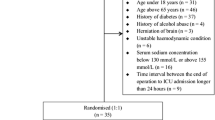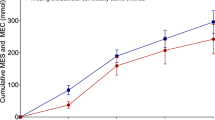Abstract
Purpose
Measuring or calculating plasma osmolality is of interest in critical care medicine. Moreover, the osmolal gap (i.e. the difference between the measured and calculated osmolality) helps in the differentiation of metabolic acidosis. A variety of formulas for calculating osmolality have been published, most of them relying on sodium, urea and glucose. A novel formula developed by Zander has recently been published, which also takes into account the effects of potassium, chloride, lactate and bicarbonate on osmolality. We evaluate the previously published formulas including the novel formula by comparing calculated and measured osmolality.
Methods
Arterial or venous blood samples from 41 outpatients and 195 acutely ill inpatients (total 236 subjects) were used to compare measured osmolality with calculated osmolality as obtained from 36 published formulas including the new formula. The performance of the formulas was statistically evaluated using the method of Bland and Altman.
Results
Mean differences up to 35 mosmol/kg H2O were observed between measured and calculated osmolality using the previously published formulas. In contrast, the novel formula had a negligible mean difference of 0.5 mosmol/kg H2O. The novel formula also had the closest 95 % limits of agreement ranging from −6.5 to 7.5 mosmol/kg H2O.
Conclusion
Only 4 out of the 36 evaluated formulas gave mean differences between measured and calculated osmolality of less than 1 mosmol/kg H2O. Zander’s novel formula showed excellent concordance with measured osmolality and facilitates a more precise diagnosis based on blood gas analysers. The new equation has the potential to replace separate measurements of osmolality in many cases.

Similar content being viewed by others
References
US National Library of Medicine. http://www.ncbi.nlm.nih.gov/mesh?term=osmolality. Accessed on 10 Sept 2012
Zander R (2009) Fluid management, 2nd edn. Bibliomed, Melsungen, Germany. http://www.physioklin.de/fileadmin/user_upload/literatur/z/fluid_management_1109.pdf. Accessed 10 Sep 2012
Rasouli M, Kalantari KR (2005) Comparison of methods for calculating serum osmolality: multivariate linear regression analysis. Clin Chem Lab Med 43:635–640
Glasser L, Sternglanz PD, Combie J, Robinson A (1973) A serum osmolality and its applicability to drug overdose. Am J Clin Pathol 60:695–699
Purssell RA, Lynd LD, Koga Y (2004) The osmole gap as a screening test for the presence of toxic substances: a review of the literature. Toxicol Rev 23:189–202
Zander R (2012) Optimale Berechnung der Osmolalität. Physioklin, Mainz. http://www.physioklin.de/physiopoc/saeure-basen-sauerstoff-elektrolyt-status/optimale-berechnung-der-osmolalitaet.html. Accessed 10 Sep 2012
Bland JM, Altman DG (1999) Measuring agreement in method comparison studies. Stat Methods Med Res 8:135–160
Krahn J, Khajuria A (2011) Is osmol gap an effective screen in accurate prediction of toxic volatiles? Clin Lab 57:297–303
Edelman IS, Leibman J, O’Meara MP, Birkenfeld LW (1958) Interrelations between serum sodium concentration, serum osmolarity, and total exchangeable sodium, total exchangeable potassium, and total body water. J Clin Invest 37:1236–1256
Holmes JH (1962) Measurement of osmolality in serum, urine and other biologic fluids by the freezing point determination. American Society of Clinical Pathologists, Chicago, IL
Jackson WP, Forman R (1966) Hyperosmolar nonketotic diabetic coma. Diabetes 15:714–722
Nelson VA, Scheidt RA (1969) Personal communication
Winters RW (1968) Disorders of electrolyte and acid-base metabolisms. In: Barnett HL (ed) Pediatrics, 14th edn. Appleton-Century-Crofts, New York, pp 336–368
Mahon WA, Holland J, Urowitz MB (1968) Hyperosmolar, non-ketotic diabetic coma. Can Med Assoc J 99:1090–1092
Jetter WW (1969) Clinical osmometry. Pa Med 72:75–79
Ross EJ, Christie SB (1969) Hypernatremia. Medicine (Baltimore) 48:441–473
Stevenson RE, Bowyer FP (1970) Hyperglycemia with hyperosmolal dehydration in nondiabetic infants. J Pediat 77:818–823
Hoffman WS (1970) The biochemistry of clinical medicine, 4th edn. Year Book Publishers, Chicago, IL, p 228
Sadler JH (1970) Personal communication
Gerich JE, Martin MM, Recant L (1971) Clinical and metabolic characteristics of hyperosmolar nonketotic coma. Diabetes 20:228–238
Boyd DR, Baker RJ (1971) Osmometry: a new bedside laboratory aid for the management of surgical patients. Surg Clin North Am 51:241–250
Weisberg HF (1971) Osmolality. American Society of Clinical Pathologists, Chicago III, Clinical Chemistry Check Sample CC-71 pp 1–49
Wilson RF (1973) Fluids, electrolytes, and metabolism. Charles C Thomas, Springfield, IL
Kopp JB (1973) Osmolality study. Product literature for Wescor (Logan, UT) vapour pressure (“dew point”) osmometer Model 5100
Dorwart WV (1973) Serum osmolality—methods of calculation from chemistry values and use of these values as a prognostic indicator (abstract 020). Clin Chem 19:643
Dorwart WV, Chalmers L (1975) Comparison of methods for calculating serum osmolality from chemical concentrations, and the prognostic value of such calculations. Clin Chem 21:190–194
Jenkins PG, Larmore C (1974) Letter: hyperglycemia-induced hyponatremia. New Engl J Med 290:573
Bhagat CI, Garcia-Webb P, Fletcher E, Beilby JP (1984) Calculated vs measured plasma osmolalities revisited. Clin Chem 30:1703–1705
Snyder H, Williams D, Zink B, Reilly K (1992) Accuracy of blood ethanol determination using serum osmolality. J Emerg Med 10:129–133
Hoffman RS, Smilkstein MJ, Howland MA, Goldfrank LR (1993) Osmol gaps revisited: normal values and limitations. J Toxicol Clin Toxicol 31:81–93
Wojtysiak B, Duma D, Solski J (1999) The new equation for calculated osmolality. Ann Univ Mariae Curie Sklodowska 7:59–64
Koga Y, Purssell RA, Lynd LD (2004) The irrationality of the present use of the osmole gap: applicable physical chemistry principles and recommendations to improve the validity of current practices. Toxicol Rev 23:203–211
Varley H, Gowenlock AH, Bell M (1980) Practical clinical biochemistry, 5th edn. Heinemann, London, pp 776–777
Khajuria A, Krahn J (2005) Osmolality revisited—deriving and validating the best formula for calculated osmolality. Clin Biochem 38:514–519
Bianchi V, Bidone P, Arfini C (2009) Siero ed urine: osmolalita calcolata o osmolalita misurata? RIMeL/IJLaM 5:206–211
Acknowledgments
The study was funded by Roche Diagnostics Graz GmbH, Research and Development, Kratkystraße 2, 8020 Graz, Austria. Roche Diagnostics was involved in the design of the study and data collection, and contributed to revision of the manuscript.
Conflicts of interest
A.S.F. and H.J.S. declare no conflicts of interest; G.C.F. receives lecture fees from Roche Diagnostics; R.Z. has previously worked as a consultant for Roche Diagnostics; D.S.K. and I.Z. are current employees of Roche Diagnostics; H.R. is a former employee of Roche Diagnostics.
Author information
Authors and Affiliations
Corresponding author
Appendix
Appendix
The development of Zander’s optimized equation for plasma is described in three steps. The following is the English translation of Zander’s original publication, which can be accessed via the Physioklin website (http://www.physioklin.de/physiopoc/saeure-basen-sauerstoff-elektrolyt-status/optimale-berechnung-der-osmolalitaet.html):
-
1.
Addition of all osmotically active constituents in terms of mosmol per liter of plasma results in the theoretical osmolarity, expressed in mmol/l. Amounts (mmol/l) of 142 Na, 4.5 K, 1.3 ionized Ca, 0.7 ionized Mg, 103 Cl, 24 HCO3, 1.5 lactate, 1 HPO4, 0.5 SO4, 3.0 organic acids plus proteinate, 5 glucose and 5 urea were taken as normal values from the literature [2]. The resulting value amounts to 291.5 mosmol/l.
-
2.
Corresponding to the fact that electrolytes, mainly sodium and chloride, are osmotically active only in part, i.e. only to 92.6 % (the so called osmotic coefficient 0.926; for glucose 1.013) [2], the resulting real osmolarity amounts to only 269.9 mosmol/l.
-
3.
Taking into account the water content of plasma with 94 % the calculated real osmolality of 287.2 mosmol/kg H2O is given a value, which has been lowered by 6 % as a result of the reduced distribution space of all osmotically active substances.
Now, comparison between the measured normal value of plasma osmolality (288 mosmol/kg H2O) and the calculated value (287 mosmol/kg H2O, rounded) leads to the surprising result that the measured real normal value of osmolality is by chance the same as the osmolarity of the plasma. This might be the reason for the confusion within the literature concerning these two values. On this basis, the optimized formula for calculation of osmolality is as follows (the concentrations of calcium and magnesium and those of phosphate, sulphate, organic acids and proteinate are summarized as constants for clinical reasons):
Osmolarity (mosmol/l) = [Na+ (142) + K+ (4.5) + const. Ca++/Mg++ (2.0) + Cl− (103) + HCO3 − (24) + lactate− (1.5) + const. phosphate/sulphate/organic acids/proteinate− (4.5) + glucose (5.0) + urea (5.0)] = 291.5 mosmol/l × 0.926 (osmot. coefficient) = 269.9 mosmol/l.
Osmolality (mosmol/kg H2O) = osmolarity: 0.94 (water content) = 287.1 mosmol/kg H2O.
The calculation of plasma osmolality (mosmol/kg H2O) is now given as:
Plasma osmolality = (Na+ + K+ + Cl− + lactate− + glucose + urea + HCO3 − + 6.5) × 0.985.
Rights and permissions
About this article
Cite this article
Fazekas, A.S., Funk, GC., Klobassa, D.S. et al. Evaluation of 36 formulas for calculating plasma osmolality. Intensive Care Med 39, 302–308 (2013). https://doi.org/10.1007/s00134-012-2691-0
Received:
Accepted:
Published:
Issue Date:
DOI: https://doi.org/10.1007/s00134-012-2691-0




